Nazis are the absolute worst, and for yet another reminder of that age-old fact, there’s Nail Bomber: Manhunt, Netflix’s non-fiction revisitation of the 1999 London bombings that left three people dead and nearly 150 injured. Carried out by a neo-Nazi named David Copeland whose motivation was “to cause a racial war in this country,” the three attacks against England’s Black and gay communities terrorized the country and, for a time, baffled police. While director Daniel Vernon’s documentary (premiering May 26) doesn’t dig deeply enough into its tale—preferring instead to reside on the suspenseful surface throughout—it serves as a chilling warning that multicultural societies remain at risk from white-nationalist outfits that view homogeny as the only true path forward, and Hitler as their guiding light.
Nail Bomber: Manhunt is a straightforward chronological retelling of this notorious period in London’s history, employing archival footage and interviews with survivors and investigators to lay out the specifics of its saga. Of particular note is the participation of “Arthur,” a man who speaks to director Vernon while wearing a hoodie, his face concealed in shadow in order to keep his true identity a secret. As a young anti-fascist, Arthur joined the intelligence-gathering wing of Searchlight, an anti-fascist magazine whose mission was to infiltrate and monitor fascist groups. Going undercover as a hatemonger was a harrowing assignment for Arthur—as well as a thrilling one, with the covert operative admitting, “I like being a spy. It’s a buzz.”
Arthur’s main target was the British National Party (BNP), a far-right political group led by John Tyndall, who in archival footage is seen spewing anti-immigrant, pro-white ugliness to legions of uniformly Caucasian admirers (as one person puts it, Tyndall was “a magnet for misfits, lunatics, and losers”). Those followers, Arthur and others explain, were typically working-class intolerant men who’d attend BNP meetings held at pubs, where literature about the Nazis and making bombs, as well as hit lists about preferred targets, were freely disseminated. The idea was to rile up the Nazi faithful, get them drunk, and give them ideas about who to strike out against—and strike out they did, often leaving these gatherings and promptly assaulting innocent pedestrians.
It was in this milieu that Copeland found a home, although despite the young man once appearing in a photo alongside Tyndall, police initially had no clue who Copeland was, much less that he was the fiend behind the bombings. When the first device went off in a crowded market street in Brixton, south London, on Saturday, April 17, 1999, it came without warning. It was a miracle that no one was fatally hurt, and Vernon’s documentary benefits from firsthand accounts of the moments directly before and after the blast. Two men recount how, after finding the bomb, they watched as a drug addict literally removed the explosive from the bag and then ran off with the bag—an absurd and unreal sight that, to this day, leaves them astonished.
Two more detonations swiftly followed: on Saturday, April 24, on Brick Lane in London’s East End, and on Friday, April 30, at The Admiral Duncan pub (a prominent gay venue) on Old Compton Street in Soho, central London. In each case, the bomb was designed for maximum carnage, its hundreds of nails intended to maim and kill. Though police were apparently slow to concede that the first two attacks were racially motivated—or that the killer had an interest in slaughtering minorities—the investigation soon turned on CCTV footage from the bombings and the surrounding areas, which revealed a young white male in a white baseball cap carrying around suspicious shoulder bags. Flyers and posters were plastered across London and broadcast on the news and in the papers, and once that happened, Nail Bomber: Manhunt turns its attention back to Arthur, who took one look at the photographs and realized that he potentially knew the perpetrator: a man known to him as “Dave from Barking.”
Arthur is the most fascinating figure in Nail Bomber: Manhunt, confessing that the longer he stayed undercover with his white-nationalist BNP brothers, the more he became indoctrinated by their repugnant ideology, to the point that he “doubted the Holocaust happened.” Arthur’s candidness speaks directly and scarily to the way in which immersion in bubble-like environments—in person, and online—can result in brainwashing, and the selflessness of his sacrifice is hammered home during the film’s coda. Nonetheless, director Vernon misses an opportunity by not spending more time with Arthur—a decision undoubtedly guided by the need to protect him from his dangerous Nazi cohorts (who still believe he’s one of them) but deprives the proceedings of greater insight into his work.
Nail Bomber: Manhunt’s superficiality extends to its refusal to both properly ID any of its on-camera speakers, and to tell us anything substantial about Copeland, whose path to terrorist neo-Nazism (and “to spread fear, resentment, and hatred”) is left wholly unremarked-upon. Even hints about Copeland’s homosexuality—which might have compelled him to carry out the Soho attack—are consigned to a brief audio clip of him angrily asserting his heterosexuality to the cops. Like the role that author Bernard O’Mahoney played in tricking Copeland to admit that he was fit to stand trial (through love letters in which O’Mahoney posed as a doting Aryan woman who admired the bombings), Copeland’s sexuality and general backstory are two of the many ripe-for-exploration threads that wind up sidelined by director Vernon, who prizes concision and propulsion (the entire affair runs a fleet 72 minutes) over depth.
Images of inner audio-tape mechanisms and kaleidoscopic CT scans are the sole formal flourishes utilized by Nail Bomber: Manhunt, which otherwise tackles its chosen subject with taut efficiency and restraint (aided by Andrew Phillips’ nerve-wracking score). The lesson it forwards is a familiar one about white-nationalist fury (and its attractiveness to certain segments of the population), and the difficulty of thwarting lone-wolf terrorists. But in an age of increased neo-Nazi hate and minority-targeting crime, its timely resonance is impossible to miss.


